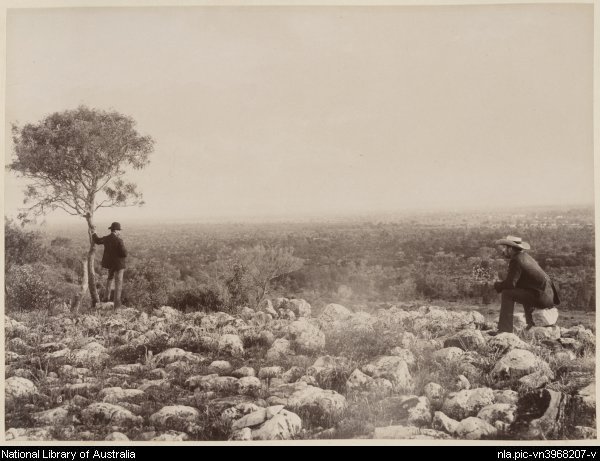
'An aphorism, properly stamped and molded, has not been "deciphered" when it has simply been read; rather one has then to begin its interpretation, for which is required an art of interpretation.' -- Nietzsche, 'On the Genealogy of Morals'
|
|
'An aphorism, properly stamped and molded, has not been "deciphered" when it has simply been read; rather one has then to begin its interpretation, for which is required an art of interpretation.' -- Nietzsche, 'On the Genealogy of Morals'
|
|
|
Charles Bayliss + the Australian landscape
« Previous |
|Next »
|
|
|
September 12, 2010
Charles Bayliss was an important nineteenth century photographer in settler Australia whose photographic heyday was the 1870s and 1880s.
 Charles Bayliss, Group of Aboriginals at Dunlop Station homestead, Darling River, New South Wales
1886, (NLA)
Charles Bayliss, Group of Aboriginals at Dunlop Station homestead, Darling River, New South Wales
1886, (NLA)
His specialisation involved two main areas: photography of the natural and of the built environments. These conformed to the standard fare of the view trade, which underpinned Bayliss’s livelihood for the next 20 years.
 Charles Bayliss, Looking south from Dunlop Range overlooking Louth, Darling River, New South Wales 1886, (NLA)
Charles Bayliss, Looking south from Dunlop Range overlooking Louth, Darling River, New South Wales 1886, (NLA)
Helen Ennis in A Modern Vision: Charles Bayliss, Photographer, 1850–1897 says that the image Looking South from Dunlop Range, Overlooking Louth, Darling River
deploys some of his trademark visual devices, with two men positioned strategically at either side of the image (surely the man at the left was instructed to lean against the tree to reinforce the vertical axis and to provide a counterpoint to his seated companion). Each man looks in a different direction, leading the viewer’s eye both ways across the composition. This is a strategy Bayliss used well, making us aware simultaneously of the act of looking at the landscape and of constructing it as an image.
Ennis says that in his landscapes from the late 1870s onwards, Bayliss employed a range of approaches that demonstrated his mastery of the dominant aesthetic conventions of the picturesque and the sublime:
The views that exemplify the sublime are relatively few: the unpeopled vistas of the Blue Mountains with their endlessly rolling hills, or scenes of the Grose Valley in which small figures perch on rocks in the foreground to provide a measure of scale and drama. Variations on the sublime include highly analytical, impersonal images of rock faces and natural features that are unyielding and implacable. In them, Bayliss uses an indeterminate vantage point that blocks any possibility of entry; there is no rock to step on to in the foreground, no pathway for the viewer to take through the scene.Generally, however, he was attracted to less dramatic but no less beautiful scenery. Some of Bayliss’s quietest images are the most enduring; they still operate within a romantic framework and draw from a deep appreciation of nature. They are not, however, concerned with evoking a sense of awe so much as a particular mood.
In the1880s, this mood is private and intensely solitary: a single person—sometimes in a boat—is held completely within the scene. Beyond the frame there is no other world. Such images address the viewer in a highly individual fashion, inviting a contemplative state, a state of reverie.
|
|
|
|
|
|
|
|
|
|
|

I always felt these traditions Ennis speaks of had their roots in Painting?